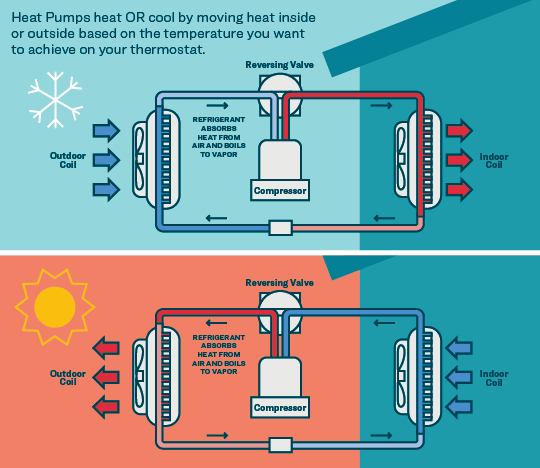Heat pumps have been making the headlines in recent months, but this may be the first time many Americans are hearing about the versatile, clean appliance that heats AND cools homes and businesses. So what exactly is this energy efficient machine with the confusing name, and why is it so exciting for the climate and, potentially, your household bottom line?
The Technology
The reason a heat pump has its name, even though it also cools, is because of how it works, not what it does. A gas- or oil- powered furnace or air conditioning system warms air up with a flame or burner or cools it down with a refrigerated coil, respectively, to reach the desired indoor temperature.
A heat pump, on the other hand, moves hot air around to achieve the temperature on your thermostat instead of actually heating or cooling the air.
You may remember from your high school physics class that all air, even cold air, has heat. So, what a heat pump does is move that heat and put it where you want it. In the summer that means taking heat out of the air inside your house and moving it outside. In the winter, it means taking the heat from outside and moving it in. Recent advancements mean heat pumps work efficiently even when the outside air temperature drops well below zero degrees fahrenheit. The same technology can be used for water heaters, too.
That’s what makes a heat pump so versatile in heating and cooling buildings: it can do both simply by moving air around.
Zero Emissions
Unlike most furnaces or air conditioners on the market that are powered by fossil fuels — like methane gas (so-called “natural” gas), propane, and oil — heat pumps are
electrically powered. Relying on electricity means that heat pumps do not burn dirty fuels inside your home to be breathed in or released into the atmosphere. Combusting gas or oil in a furnace or air conditioning system releases air pollutants that are harmful to human health and the climate, like nitrogen oxides, carbon monoxide, particulate matter, and climate-disrupting carbon dioxide.
These pollutants directly, and seriously, impact human health, from increasing the rates of asthma to causing thousands of premature deaths each year.
For the average US home, installing electric heat pumps in place of a gas furnace and gas water heater will reduce heating emissions more than 45 percent over the next 10 years. That’s the equivalent of cutting a gas-powered car’s carbon pollution by more than half.
Replacing polluting gas furnaces with clean electric heat pumps will decrease carbon pollution in every state over the next 10 years of the appliance’s life -- even in states that still rely heavily on coal to power their electricity grid, according to an analysis by the Sierra Club. And the electrical grid in the United States is increasingly moving towards renewable and decarbonized sources; a transition that will happen even faster thanks to grant and loan programs in the recently passed Inflation Reduction Act of 2022 for states and electric utilities to decarbonize the grid through investing in renewable power and clean technologies.
Energy Efficient & Budget Friendly
Analysis by RMI found that heat pumps are “2.2 to 4.5 times more efficient than an Energy Star gas furnace.” Moving to highly efficient heat pump technology can dramatically reduce energy use for cooling homes, alleviating strain on the electrical grid on hot days when electricity demand is high. The same is true for cold weather. Moving to highly efficient heat pump technology can reduce energy use for heating by up to 50 percent or more.
All of this energy savings means consumers will spend less money on their utility bills. According to a report from Rewiring America, replacing fossil fuel furnaces and water heaters with clean electric alternatives can immediately lower costs for 103 million of America’s 121 million homes — savings that amount to more than $37 billion.
Building new homes with electric appliances that run on renewable energy is nearly always less expensive than building homes with polluting fossil fuel appliances. Electrifying existing homes and buildings with fossil fuel appliances is also often cost effective, especially for households that are: 1. Switching away from propane or heating oil; 2. Replacing both a gas furnace and an air conditioning unit; 3. Bundling rooftop solar with electrification.
But there are, of course, upfront costs to retrofitting a home with heat pump technology. So, subsidies for these highly-efficient appliances are key to supporting households in making the switch. Many states offer incentives for converting to a heat pump, and the federal government is committed to helping households make the switch, too. The federal Inflation Reduction Act of 2022 invests billions of dollars to make household electrification and clean energy upgrades significantly more affordable for consumers, including rebates for low- and moderate-income households to make the switch to electrification.
It is imperative that the United States equitably increases the amount of buildings in the country with affordable, zero-emission, and highly efficient heat pump technology. Doing so will save consumers money, make an increasingly clean grid more reliable, ensure the country is less dependent on volatile and dirty fossil fuels, and help reduce harmful air pollution and meet critical climate goals.
